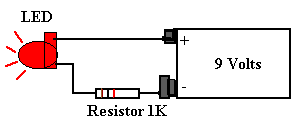- Electronics is the technology of controlling the flow of electrons.
- Electrons exist as particles swirling around the nucleus of the atom.
- When an electromotive force is present, electrons will move through some materials.
- The force moving electrons is measured in volts.
- A battery is a chemical device, designed to provide the force needed to move electrons.
- Electrons move from the (-) end of the battery and are attracted to the (+) end.
- A circuit is a complete path ( - to + ) for electrons to move on.
- Some materials impede the flow of electrons, this is called resistance.
- Resistors are devices designed to provide resistance in a circuit.
- Resistance is measured in ohms.
- The number of electrons moving in a circuit is called current.
- Current is measured in amperes (amps).
- The relationship among voltage, current and resistance is defined by Ohm's Law.
- Ohm's law: voltage = current x resistance, V = I*R
- V = voltage (volts), I = current (amps), R = resistance (ohms)
A basic circuit:
Supplies:
You have been given cash to go buy these items. You can find Radio Shack on 3rd Street. You are to collect these items and create a basic circuit for Thursday Class. Your toy(s) are also due on Thursday. It would be wise to gather either a swiss army knife, weatherman, or small screwdriver set for taking your toys apart. Good Luck and be imaginative. YOu do not necessarily need to know how you will use the toy but give yourself options when choosing.
- 1 LED (Radio Shack # 276-18)
- 1 - 1000 ohm resistor (Radio Shack # 271-1321)
- 1 - 9V Battery
- 1 - 9V Battery clip (Radio Shack # 270 - 325)
Construction:

LED's (Light Emitting Diodes) are easily damaged if too much current flows through them. For this reason it is necessary to use a resistor to reduce the current flow. Note that LED's have a "+" and "-" lead, the "-" lead is beside a "notch" in the plastic base of the LED. If you connect an LED backwards it won't work. See "Sources" at the bottom for ideas on where you can get more information.
